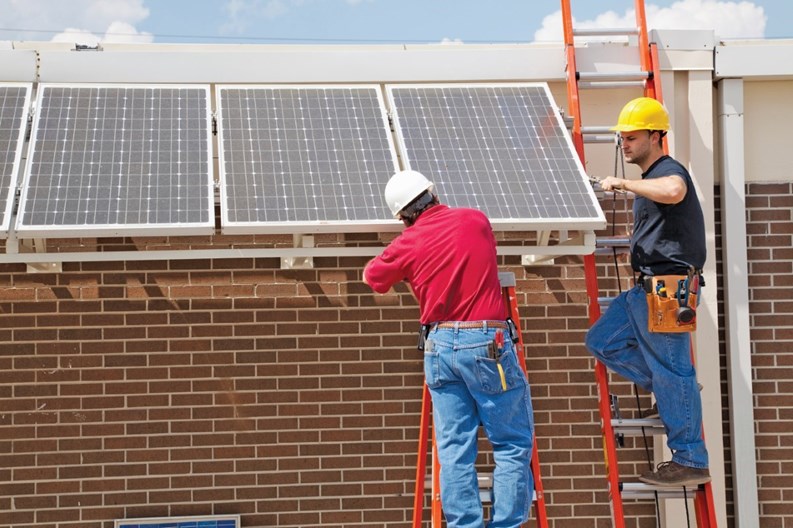The emergence of environmental problems and the corresponding need to reduce carbon emissions, combined with tough economic conditions worldwide, is leading more multifamily residential communities to work toward conserving energy and becoming more “green.” In recent years, being green has become more than just a trendy buzzword—for many Garden State HOAs, it’s now a way of life. More and more communities are adopting and implementing environmentally-sensitive policies, and intentionally using more eco-friendly products.
Taking a greener course makes sense for many residents, who see helping the environment and saving money for their association’s operating expenses as worthy benefits of using green practices in their communities. While many residents recognize the value in being environmentally friendly, and will often pay a premium to do so, some green measures can be implemented in a community without being prohibitively expensive. Not only board members and property managers, but average residents also can take advantage of the green programs available to help defray the cost of greening their developments. Starting the process is often as simple as going online, finding the pertinent information and applying for the program right then and there.
Looking for Green
Opportunities and options for going green are constantly multiplying. Municipalities, states and the federal government offer aid in the form of tax credits, free equipment upgrades, and other incentives for green measures, and more eco-friendly products are delivered to market each year.
Decades ago, there were no government-sponsored energy/environmental preservation incentive programs for multifamily buildings. But as public awareness has grown regarding the effect of daily activities on the environment, green programs have proliferated. Greater demand is driving the increase in green options, and now residents of multifamily communities and buildings can find savings by upgrading their homes with more eco-friendly materials and appliances.
“If you replace a piece of equipment with higher efficiency equipment, you might be able to get a rebate,” says Mitch Frumkin, a Certified Green Professional, a licensed professional engineer and president of the North Brunswick-based engineering consulting firm Kipcon, Inc.
A resident can get a $75 federal government rebate for replacing an old washing machine with a new, energy efficient washing machine, said Allan Samuels, co-owner of Energy Squared, a residential consulting firm that is a division of Kipcon. But such small appliance rebates are just the tip of the green incentives iceberg.
One of New Jersey’s earliest green programs for multifamily buildings was the Department of Community Affair’s (DCA) New Jersey’s Affordable Green program, says Lisa Ryan, a spokeswoman for the DCA. The Affordable Green program offered developers funding for green building items they could select from a menu of options. Each option had a per-unit value, with a maximum of $7,500 per unit for a participating development project. The program’s goal was to encourage developers to incorporate green building practices into their affordable multifamily developments.
The NJ Affordable Green program preceded the state’s current Green Future program, which is administered through the New Jersey Housing and Mortgage Finance Agency (HMFA). The Green Future program helps developers earn “green points” in the competitive application for low-income housing tax credits. According to Ryan, the program takes the best green building measures from the Affordable Green program and other green building programs such as the U.S. Green Building Council’s LEED Certification program, and it requires completion of all items on the Green Future checklist.
New Jersey’s ENERGY STAR Homes is an energy-efficiency program that encourages many of the same building improvements that are required by Green Future, the U.S. Green Building Council and other green programs. This program is required of many of the projects that are funded by the HMFA.
“The program has several tiers, encouraging increased energy efficiency, with the latest tier added being a “microload” tier called NJ Climate Choice that requires a building to be 55-percent more energy efficient than what is required by the state’s Energy Code,” Ryan says.
Energy Star is also a federal government classification of energy efficient appliances, windows, lights, and other mechanisms used in residential living. The program offers rebates for consumers who replace items—including heating systems and windows—with higher efficiency systems and items. Energy Star-approved products bear a seal that states that they are approved by the program.
According to Ryan, several new energy-efficiency programs, funded by the federal American Recovery and Reinvestment Act of 2009, will soon be offered to New Jersey residents. These programs will provide low- or no-cost funding for multifamily properties across the state to promote efficiency improvements and provide utility cost reduction for participating properties.
For the early adopter who’s prepared to make a significant investment in his or her property, alternative energy generation could be one answer to the current energy crunch. Many incentives are available for improving the energy efficiency of homes and buildings, and for the installation of renewable energy systems in homes. Programs offering financial incentives include Energy Star Homes, Home Performance with Energy Star, NJ SmartStart Buildings, Direct Install, Pay for Performance, and the Renewable Energy Incentive Program, Ryan says.
Spending to Save
While public perception has yet to catch up to the reality of this situation, solar energy use for HOAs can be a cost-effective proposition. Solar units can provide up to 90-percent of a residential unit’s electrical usage, saving from $30,000 to $100,000 per unit, says Paul Rosengren, a spokesman for Newark-based Public Service Enterprise Group (PSEG). PSEG administers several rebate programs for solar, wind and other alternative energy uses.
“Our Solar Loan Program provides for 60-percent of the cost of a loan for solar energy installation in a residence or business,” Rosengren says. “It creates a solar energy credit. You’re really only paying for 15-percent of installation.”
A meter placed on the solar production unit measures how much energy is being generated. Solar Renewable Energy Credits, or SRECs, are sold to power providers. Sales of those credits are applied to the loan for the solar installation, helping to pay off part of the cost of the unit. Some renewable energy systems for residential properties can pay themselves off in as little as two years, Rosengren says.
PSEG’s Energy Efficiency Program helps residents in Newark and Trenton to receive energy audits of their homes and businesses. Homes and businesses that replace lights and caulking and install programmable thermostats can receive rebates for making these eco-conscious investments.
Energy efficiency rebate programs require varying degrees of commitment by homeowners and associations. Small improvements, such as the aforementioned changes in lights, electrical controls, and caulking, can add up to great savings. Installing appropriate electrical controls in a home can save from five to 10 percent on the energy usage in the home, Frumkin says.
For larger projects, such as new HOA developments or expansions of existing developments, the ENERGY STAR Homes plan offers significant per-unit incentives from the New Jersey Clean Energy Program, Ryan says. The program covers the cost of plan review, efficiency upgrade recommendations, and inspections to ensure projects’ energy efficiency at completion. Developers commit to completing the program and submit to inspection.
The benefits of green building don’t just begin and end with a builder’s involvement in an incentive program, either. According to Ryan, “After completing several projects, developers have indicated that many of the prescribed measures have become part of their everyday building standards, even if they aren’t participating in the program.”
Part of making a wise investment in energy efficiency requires doing things in the proper order. Thus, it’s essential to do a little homework before buying equipment to upgrade one’s home or association. Anyone looking to replace different pieces of equipment in their unit or building should first make sure any and all necessary paperwork is filled out and accepted in order to be eligible for the rebate program.
It’s also important to be approved by a program before buying the equipment for which one hopes to receive a rebate. Also, says Frumkin, it’s smart to remember how much money can be saved by just making small upgrades in a building. “We have found that in most buildings, making some simple changes can amount to a 15-percent savings [in energy usage],” he says.
Ryan reminds residents that saving by being green isn’t just about rebates, nor is it limited to decreased usage resulting from upgrades. Cost savings will come from the improved durability of new materials, as well as from the improved energy efficiency of the building.
Who to Call
Because there are various programs through which a homeowner might qualify for financial incentives to implement energy-saving measures in their homes, some residents can be confused about where look for help in upgrading their windows, furnaces, or home electrical systems. For some, it makes more sense to contact a consultant who can walk them through the process of making their homes more energy efficient.
Professional green consultants like Frumkin and Samuels can help. They work together, consulting homeowners on green living and who also give seminars that educate on how to “green” one’s home, say a little direction from specialists can make a big difference in helping a homeowner to reduce his energy usage. The men, both engineers, specialize in energy efficiency and see gold in the details of making a home more eco-friendly.
“In this economy, there’s a huge desire of many people to save money,” Frumkin says. “And these measures can save money.”
Certain organizations are good starting points for homeowners interested in learning more about saving energy in their homes. The Clean Energy Program of the New Jersey Board of Public Utilities (NJBPU), based in Newark, is one place for a homeowner to begin the search for a greener way. Before implementing green measures in one’s home, it also makes sense to contact the Public Service Energy Group and get the advice of one of its professionals.
Many energy efficiency program documents are available online at www.njgreen.gov. Residents can learn more about how to save money while making their homes greener by visiting www.njcleanenergy.com.
Residents who want to learn more about greening their homes also can attend New Jersey’s ARRA program rollout, or they can visit the Clean Energy Program website, Ryan says. They also can consult the Green Homes Office website, visit the NJGreen Tab at www.NJ.gov, and sign up for the Green Homes Listserv.
Jonathan Barnes is a freelance writer and a frequent contributor to The New Jersey Cooperator and other publications.







Leave a Comment